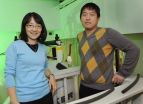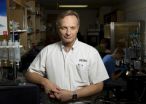(Press-News.org) Settling decades of scientific debate, researchers from UCLA and the British Antarctic Survey have discovered the final link between electrons trapped in space and the glow of light from the upper atmosphere known as the diffuse aurora.
The finding will help scientists better understand space weather and how space storms affect the Earth's atmosphere from the top down, with potential benefits for the satellite, power-grid and aviation industries, the researchers said.
Their research appears Oct. 21 in the journal Nature.
Scientists have long known that the diffuse aurora is caused by electrons striking the Earth's upper atmosphere. The question has long been how these electrons reach the atmosphere, since electrons are normally trapped much higher up in the Earth's magnetic field through a long chain of events starting with the sun.
Since the 1970s, scientists have debated whether very low-frequency (VLF) radio waves could be responsible for scattering the trapped electrons into the atmosphere. Two types of VLF waves were identified in space as the possible cause of the diffuse aurora, but despite years of argument and research, no conclusive result had been reached.
The new research shows, "without doubt, that VLF waves known as 'chorus' are responsible, so-called since the signals detected by ground-based recording equipment sound like the bird's dawn chorus when played back through a loud speaker," said the Nature paper's lead author, Richard Thorne, a UCLA professor of atmospheric and oceanic sciences.
Chorus waves are very low-frequency radio waves that come from space and are first detected on the ground.
Through detailed analysis of satellite data, Thorne and his colleagues were able to calculate the effects on the trapped electrons and identify which radio waves were causing the scattering.
"The breakthrough came when we realized that the electrons being lost from space to the Earth's atmosphere were leaving a signature, effectively telling a story about how they were being scattered," Thorne said. "We could then analyze our satellite data on the two types of VLF waves, and by running calculations on them — including the rate at which the electrons were being lost to the Earth's atmosphere — we could clearly see that chorus waves were the cause of the scattering."
"Our finding is an important one because it will help scientists to understand how the diffuse aurora leads to changes in the chemistry of the Earth's upper atmosphere, including effects on ozone at high altitude, which may affect temperature right through the atmosphere," said co-author Professor Richard Horne of the British Antarctic Survey. "We are also including the VLF waves in computer models to help predict 'space weather,' which affects not only satellites and power grids, but also the accuracy of GPS navigation and high-frequency radio communications with aircraft on polar routes."
The diffuse aurora is not the same as the discrete aurora, also known as the northern and southern lights. The discrete aurora looks like fiery moving curtains of colorful light and can be seen by the unaided eye, while the diffuse aurora is much fainter but more extensive. The diffuse aurora, which typically accounts for three-quarters of the energy input into the upper atmosphere at night, varies according to the season and the 11-year solar cycle.
INFORMATION:
The research was funded by the National Science Foundation and by the United Kingdom's Natural Environment Research Council.
Co-authors are Binbin Ni, a researcher at UCLA; Xin Tao, a postdoctoral scholar in Thorne's laboratory of UCLA; and Nigel Meredith of the British Antarctic Survey.
Images are available at ftp://ftp.nerc-bas.ac.uk/pub/photo/Nature-diffuse-aurora/ and should be credited to British Antarctic Survey.
The British Antarctic Survey (BAS), a component of the Natural Environment Research Council, delivers world-leading interdisciplinary research in the polar regions. The BAS has more than 450 staff and operates five research stations, two Royal research ships and five aircraft in and around Antarctica.
UCLA is California's largest university, with an enrollment of more than 38,000 undergraduate and graduate students. The UCLA College of Letters and Science and the university's 11 professional schools feature renowned faculty and offer 328 degree programs and majors. UCLA is a national and international leader in the breadth and quality of its academic, research, health care, cultural, continuing education and athletic programs. Six alumni and five faculty have been awarded the Nobel Prize.
For more news, visit the UCLA Newsroom and follow us on Twitter.
END
Medical researchers at the University of New South Wales have for the first time shown a link between a father's weight and diet at the time of conception and an increased risk of diabetes in their offspring.
The finding, reported in the prestigious journal Nature, is the first in any species to show that paternal exposure to a high-fat diet initiates progression to metabolic disease in the next generation.
"We've known for a while that overweight mums are more likely to have chubby babies, and that a woman's weight before and during pregnancy can play a role in future ...
An international CSIRO-led team of astronomers has developed a new way to weigh the planets in our Solar System – using radio signals from the small spinning stars called pulsars."This is first time anyone has weighed entire planetary systems – planets with their moons and rings," said team leader Dr David Champion from Germany's Max-Planck-Institut für Radioastronomie.
"And we've provided an independent check on previous results, which is great for planetary science."
Measurements of planet masses made this new way could feed into data needed for future space missions.
Until ...
WASHINGTON, D.C., (Oct. 21, 2010) -- Over the past decade, Christine Mahoney and a team of scientists at the National Institute of Standards and Technology (NIST) in Maryland have been working to stop the threat of terrorist-based attacks in the form of explosives or explosive-based devices, by providing a sound measurement and standard infrastructure.
"Our program encompasses many different aspects of explosives research, from development of measurement standards for trace explosives detection at airports, to the development and application of new metrology for the direct ...
Measuring three biomarkers in a single blood sample may improve physicians' ability to identify patients at high risk of developing chronic kidney disease (CKD), according to a study appearing in an upcoming issue of the Journal of the American Society of Nephrology.
"Our results identify biomarkers that can improve CKD risk prediction," comments Caroline S. Fox, MD, MPH of the National Heart, Lung, and Blood Institute's Framingham Heart Study, Framingham, Mass.
The study included more than 2,300 participants in the Framingham Offspring Study, a long-term follow-up ...
NASA's Lunar Reconnaissance Orbiter (LRO) and its sophisticated suite of instruments have determined that hydrogen, mercury and other volatile substances are present in permanently shaded soils on the Moon, according to a paper published today in Science.
The Lunar Crater Remote Observation and Sensing Satellite (LCROSS), which launched with LRO, was intentionally crashed onto the Moon's surface Oct. 9, 2009, while LRO instruments watched. About 90 seconds after LCROSS hit the Moon, LRO flew past the debris plume raised by the impact, while the Lyman Alpha Mapping Project ...
AMES, Iowa – The flu virus uses a shuttle mechanism to relay protons through a channel in a process necessary for the virus to infect a host cell, according to a research project led by Mei Hong of Iowa State University and the Ames Laboratory.
The findings are published in the Oct. 22 issue of the journal Science.
Hong, an Iowa State professor of chemistry and an associate of the U.S. Department of Energy's Ames Laboratory, said her research team used solid-state nuclear magnetic resonance (NMR) spectroscopy to determine the structure and workings of the proton channel ...
Beating the flu is already tough, but it has become even harder in recent years – the influenza A virus has mutated so that two antiviral drugs don't slow it down anymore.
Reporting their findings in the journal Science, researchers from Florida State and Brigham Young move closer to understanding why not, and how future treatments can defeat the nasty bug no matter how it changes.
The two drugs, amantadine and rimantadine, are no longer recommended by the CDC for use against flu.
They used to work by blocking a hole in the influenza A virus called the "M2 channel," ...
(Embargoed) Scientists at the University of North Carolina at Chapel Hill School of Medicine have reported the exact molecular structure and mechanisms of a major cell signaling pathway that serves a broad range of functions in humans.
Up to half of drugs approved by the US Food and Drug Administration directly or indirectly target G protein-coupled receptors. These receptors, which are proteins that live in the outer membranes of cells, take molecular signals from outside the cell and convert them into responses within – and those responses help control behaviors as ...
Research led by Klaus Stark and Christian Hengstenberg of the University of Regensburg identified a common variant of the cardiovascular heat shock protein gene, HSPB7, which was found to increase risk for dilated cardiomyopathy by almost 50%. Their paper appears on October 28 in the open-access journal PLoS Genetics.
Per year, about 6 in 100,000 individuals develop dilated cardiomyopathy (DCM), with a higher prevalence in men. This disease is characterized by an enlarged, weakened heart, subsequently affecting the pumping capacity and often leading to chronic heart failure. ...
CAMBRIDGE, Mass. -- Most marathon runners know they need to consume carbohydrates before and during a race, but many don't have a good fueling strategy. Now, one dedicated marathoner -- an MD/PhD student in the Harvard-MIT Division of Health Sciences and Technology -- has taken a more rigorous approach to calculating just how much carbohydrate a runner needs to fuel him or herself through 26.2 miles, and what pace that runner can reasonably expect to sustain.
The result is a new model, described in the Oct. 21 issue of the journal PLoS Computational Biology, which allows ...



